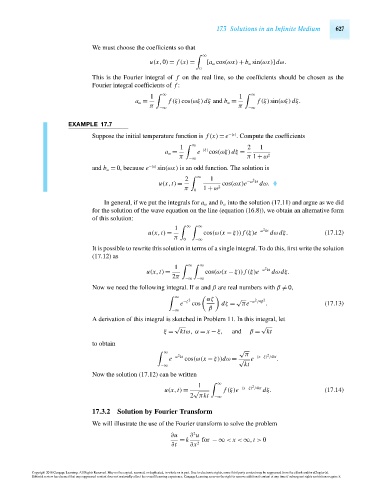Page 647 - Advanced_Engineering_Mathematics o'neil
P. 647
17.3 Solutions in an Infinite Medium 627
We must choose the coefficients so that
∞
u(x,0) = f (x) = [a ω cos(ωx) + b ω sin(ωx)]dω.
0
This is the Fourier integral of f on the real line, so the coefficients should be chosen as the
Fourier integral coefficients of f :
1 ∞ 1 ∞
a ω = f (ξ)cos(ωξ)dξ and b ω = f (ξ)sin(ωξ)dξ.
π π
−∞ −∞
EXAMPLE 17.7
Suppose the initial temperature function is f (x) = e −|x| . Compute the coefficients
1 ∞ 2 1
a ω = e −|ξ| cos(ωξ)dξ =
π −∞ π 1 + ω 2
and b ω = 0, because e −|x| sin(ωx) is an odd function. The solution is
2 ∞ 1 −ω kt
2
u(x,t) = cos(ωx)e dω.
π 0 1 + ω 2
In general, if we put the integrals for a ω and b ω into the solution (17.11) and argue as we did
for the solution of the wave equation on the line (equation (16.8)), we obtain an alternative form
of this solution:
1 ∞ ∞ 2
u(x,t) = cos(ω(x − ξ)) f (ξ)e −ω kt dω dξ. (17.12)
π 0 −∞
It is possible to rewrite this solution in terms of a single integral. To do this, first write the solution
(17.12) as
1 ∞ ∞ −ω kt
2
u(x,t) = cos(ω(x − ξ)) f (ξ)e dω dξ.
2π
−∞ −∞
Now we need the following integral. If α and β are real numbers with β = 0,
∞ 2 αζ √ 2 2
e −ζ cos dζ = πe −α /4β . (17.13)
β
−∞
A derivation of this integral is sketched in Problem 11. In this integral, let
√ √
ξ = ktω, α = x − ξ, and β = kt
to obtain
√
∞ 2 π 2
e −ω kt cos(ω(x − ξ))dω = √ e −(x−ξ) /4kt .
kt
−∞
Now the solution (17.12) can be written
1 ∞ 2
u(x,t) = √ f (ξ)e −(x−ξ) /4kt dξ. (17.14)
2 πkt −∞
17.3.2 Solution by Fourier Transform
We will illustrate the use of the Fourier transform to solve the problem
2
∂u ∂ u
= k for −∞ < x < ∞,t > 0
∂t ∂x 2
Copyright 2010 Cengage Learning. All Rights Reserved. May not be copied, scanned, or duplicated, in whole or in part. Due to electronic rights, some third party content may be suppressed from the eBook and/or eChapter(s).
Editorial review has deemed that any suppressed content does not materially affect the overall learning experience. Cengage Learning reserves the right to remove additional content at any time if subsequent rights restrictions require it.
October 14, 2010 15:25 THM/NEIL Page-627 27410_17_ch17_p611-640

